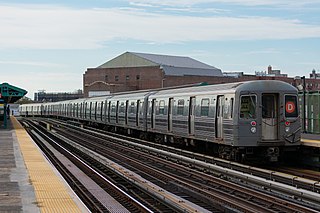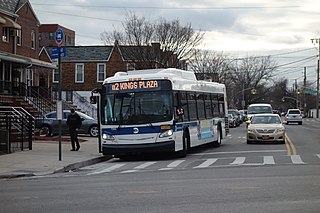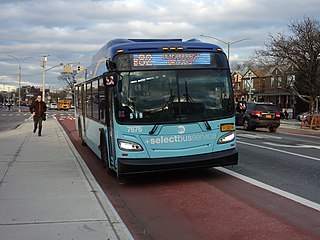
The Q Second Avenue/Broadway Express/Brighton Local is a rapid transit service in the B Division of the New York City Subway. Its route emblem, or "bullet", is colored yellow since it is a part of the BMT Broadway Line in Manhattan.
The BMT Brighton Line, also known as the Brighton Beach Line, is a rapid transit line in the B Division of the New York City Subway in Brooklyn, New York. Local service is provided at all times by the Q train, but is joined by the B express train on weekdays. The Q train runs the length of the entire line from Coney Island–Stillwell Avenue to the Manhattan Bridge south tracks. The B begins at Brighton Beach and runs via the bridge's north tracks.

The Brighton Beach station is an elevated express and terminal station on the BMT Brighton Line of the New York City Subway. It is located over Brighton Beach Avenue between Brighton 5th Street and Brighton 7th Street in Brighton Beach, Brooklyn. The station is served by the Q train at all times and is the southern terminal for the B train on weekdays only.

The D Sixth Avenue Express is a rapid transit service in the B Division of the New York City Subway. Its route emblem, or "bullet", is colored orange, since it uses the IND Sixth Avenue Line in Manhattan.

The N Broadway Express is a rapid transit service in the B Division of the New York City Subway. Its route emblem, or "bullet," is colored yellow, since it uses the BMT Broadway Line in Manhattan.

The Avenue H station is a local station on the BMT Brighton Line of the New York City Subway. It is located at Avenue H between East 15th and East 16th Streets near the border of Midwood and Flatbush, Brooklyn. The station is served by the Q train at all times. It is also served by the B train on weekdays until early 2025.

The Newkirk Plaza station is an express station on the BMT Brighton Line of the New York City Subway in Flatbush, Brooklyn. It is located on an open-cut at the center of the pedestrian-only Newkirk Plaza shopping mall, which is bounded by Newkirk Avenue on the north, Foster Avenue on the south, Marlborough Road to the west, and East 16th Street to the east. The station is served by the Q train at all times and by the B train on weekdays only.

The Sheepshead Bay station is an express station on the BMT Brighton Line of the New York City Subway. It is located in the Sheepshead Bay neighborhood of Brooklyn. It is served by the Q train at all times and by the B train on weekdays.

The B68 is a bus route that constitutes a public transit line operating in Brooklyn, New York City. The B68 is operated by the MTA New York City Transit Authority. Its precursor was a streetcar line that began operation in June 1862, and was known as the Coney Island Avenue Line. The route became a bus line in 1955.

The Avenue M station, is a local station on the BMT Brighton Line of the New York City Subway. It is located in Midwood, Brooklyn, at Avenue M between East 15th and East 16th Streets. The station is served by the Q train at all times. It is also served by the B train on weekdays until early 2025.

The Kings Highway station is an express station on the BMT Brighton Line of the New York City Subway. It is located at Kings Highway between East 15th and East 16th Streets on the border of Midwood and Homecrest neighborhoods of Brooklyn. The station is served by the Q train at all times and by the B train on weekdays only.

The Church Avenue station is an express station on the BMT Brighton Line of the New York City Subway, located at Church Avenue near East 18th Street in the Flatbush neighborhood of Brooklyn. The station is served by the Q train at all times and by the B train on weekdays only.

The Avenue X station is a local station in the Gravesend neighborhood of Brooklyn on the IND Culver Line of the New York City Subway. It is served by the F train at all times and the <F> train during rush hours in the peak direction.

The B41 is a bus route that constitutes a public transit line operating in Brooklyn, New York City, running along Flatbush Avenue between Downtown Brooklyn and the Marine Park/Mill Basin border. The B41 is operated by the MTA New York City Transit Authority. Its precursor was a streetcar line that began operation in 1860, and was known as the Flatbush Avenue Line. The route became a bus line in 1951. Limited-stop service began along the route in 1992.

The B2 is a bus route in the New York City borough of Brooklyn. Originally operated by the Brooklyn-Manhattan Transit Corporation, it is now operated by MTA Regional Bus Operations under the New York City Transit brand.

The B8 is a bus route in the New York City borough of Brooklyn, which serves the corridors of 18th Avenue and Avenue D. Originally operated by Queens Bus Lines, it is now operated by MTA Regional Bus Operations under the New York City Transit brand.

The B11 is a bus route in the New York City borough of Brooklyn, which serves the corridors of 49th Street and 50th Street. Originally operated by the Brooklyn-Manhattan Transit Corporation, it is now operated by MTA Regional Bus Operations under the New York City Transit brand.

The B82 bus route constitutes a public transit line in central Brooklyn, New York City. It connects Starrett City in southeast Brooklyn with Coney Island on Brooklyn's southwestern coast. The B82 operates primarily via Kings Highway and Flatlands Avenue in southern Brooklyn. The route is operated by MTA Regional Bus Operations, under the New York City Bus and Select Bus Service brands.

The B67 and B69 bus routes comprise a public transit line in Brooklyn, New York City. Both bus routes originated as streetcar lines: The B67 originated as the Seventh Avenue Line, while the B69 originated as the Vanderbilt Avenue Line. The current bus routes are operated by MTA Regional Bus Operations. The B67 runs primarily along Seventh Avenue, Flatbush Avenue, and Atlantic Avenue, while the B69 runs along Seventh Avenue and Vanderbilt Avenue. Although both routes' southern termini are in Kensington, Brooklyn, the northern terminus of the B67 is in Williamsburg while the northern terminus of the B69 is in Dumbo.

The B47 is a surface transit line on Ralph Avenue in Brooklyn, New York City. Once a streetcar line, it is now part of the B47 bus route, operated by the New York City Transit Authority, Prior to 1995, it was the B78 route; the northern part of the route from St. Johns Place to Woodhull Hospital was part of the B40 line. The B47 was created as a result of a merger of the B40 and B78 on September 8, 2002.






















